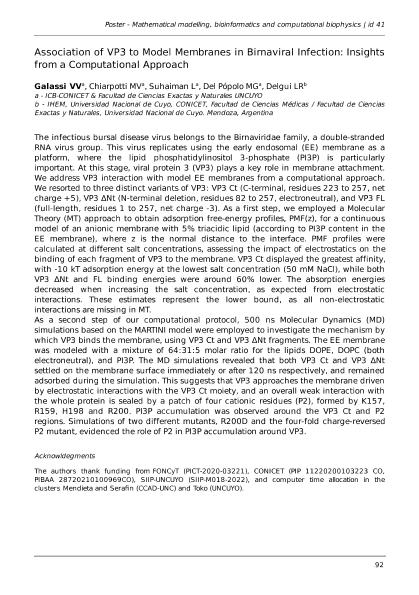Evento
Association of VP3 to model membranes in birnaviral infection: Insights from a computational approach
Galassi, Vanesa Viviana ; Chiarpotti, Maria Vanina
; Chiarpotti, Maria Vanina ; Suhaiman, Laila
; Suhaiman, Laila ; del Popolo, Mario Gabriel
; del Popolo, Mario Gabriel ; Delgui, Laura Ruth
; Delgui, Laura Ruth
 ; Chiarpotti, Maria Vanina
; Chiarpotti, Maria Vanina ; Suhaiman, Laila
; Suhaiman, Laila ; del Popolo, Mario Gabriel
; del Popolo, Mario Gabriel ; Delgui, Laura Ruth
; Delgui, Laura Ruth
Colaboradores:
Acierno, Juan Pablo ; Celej, Maria Soledad
; Celej, Maria Soledad ; Vazquez, Diego Sebastia
; Vazquez, Diego Sebastia
 ; Celej, Maria Soledad
; Celej, Maria Soledad ; Vazquez, Diego Sebastia
; Vazquez, Diego Sebastia
Tipo del evento:
Reunión
Nombre del evento:
LI Reunión Anual de la Sociedad Argentina de Biofísica
Fecha del evento:
29/11/2023
Institución Organizadora:
Sociedad Argentina de Biofísica;
Universidad Nacional de Córdoba;
Título del Libro:
Libro de Resúmenes: LI Reunión Anual de la Sociedad Argentina de Biofísica
Editorial:
Sociedad Argentina de Biofísica
ISBN:
978-987-48938-1-9
Idioma:
Español
Clasificación temática:
Resumen
The infectious bursal disease virus belongs to the Birnaviridae family, a double-stranded RNA virus group. This virus replicates using the early endosomal (EE) membrane as a platform, where the lipid phosphatidylinositol 3-phosphate (PI3P) is particularly important. At this stage, viral protein 3 (VP3) plays a key role in membrane attachment. We address VP3 interaction with model EE membranes from a computational approach. We resorted to three distinct variants of VP3: VP3 Ct (C-terminal, residues 223 to 257, net charge +5), VP3 ΔNt (N-terminal deletion, residues 82 to 257, electroneutral), and VP3 FL (full-length, residues 1 to 257, net charge -3). As a first step, we employed a MolecularTheory (MT) approach to obtain adsorption free-energy profiles, PMF(z), for a continuous model of an anionic membrane with 5% triacidic lipid (according to PI3P content in the EE membrane), where z is the normal distance to the interface. PMF profiles were calculated at different salt concentrations, assessing the impact of electrostatics on the binding of each fragment of VP3 to the membrane. VP3 Ct displayed the greatest affinity, with -10 kT adsorption energy at the lowest salt concentration (50 M NaCl), while both VP3 ΔNt and FL binding energies were around 60% lower. The absorption energies decreased when increasing the salt concentration, as expected from electrostatic interactions. These estimates represent the lower bound, as all non-electrostatic interactions are missing in MT.As a second step of our computational protocol, 500 ns Molecular Dynamics (MD) simulations based on the MARTINI model were employed to investigate the mechanism by which VP3 binds the membrane, using VP3 Ct and VP3 ΔNt fragments. The EE membrane was modeled with a mixture of 64:31:5 molar ratio for the lipids DOPE, DOPC (both electroneutral), and PI3P. The MD simulations revealed that both VP3 Ct and VP3 ΔNt settled on the membrane surface immediately or after 120 ns espectively, and remained adsorbed during the simulation. This suggests that VP3 approaches the membrane driven by electrostatic interactions with the VP3 Ct moiety, and an overall weak interaction withthe whole protein is sealed by a patch of four cationic residues (P2), formed by K157, R159, H198 and R200. PI3P accumulation was observed around the VP3 Ct and P2 regions. Simulations of two different mutants, R200D and the four-fold charge-reversed P2 mutant, evidenced the role of P2 in PI3P accumulation around VP3.
Palabras clave:
VP3
,
Birnavirus
,
Molecular Theory
,
protein binding
Archivos asociados
Licencia
Identificadores
Colecciones
Eventos(ICB)
Eventos de INSTITUTO INTERDISCIPLINARIO DE CIENCIAS BASICAS
Eventos de INSTITUTO INTERDISCIPLINARIO DE CIENCIAS BASICAS
Eventos(IHEM)
Eventos de INST. HISTOLOGIA Y EMBRIOLOGIA DE MEND DR.M.BURGOS
Eventos de INST. HISTOLOGIA Y EMBRIOLOGIA DE MEND DR.M.BURGOS
Citación
Association of VP3 to model membranes in birnaviral infection: Insights from a computational approach; LI Reunión Anual de la Sociedad Argentina de Biofísica; Córdoba; Argentina; 2023; 1-1
Compartir



